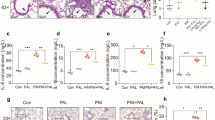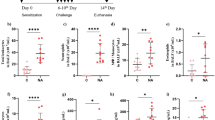Abstract
Increasing evidence demonstrates that pyroptosis, pro-inflammatory programmed cell death, is linked to acute lung injury (ALI). Dihydromyricetin (DHM) has been reported to exert anti-inflammatory effects by inhibiting NLRP3 inflammasome activation in vascular endothelial cells. However, the effects of DHM on NLRP3 inflammasome-induced pyroptosis in ALI remain elusive. In the present study, male BALB/c mice were subjected to cecal ligation and puncture (CLP), and DHM (50, 100, 150 mg/kg) was orally administered (once per day, for 3 days) 2 h after CLP. After 72 h, lung histopathology was examined, and the wet/dry (W/D) ratio, inflammatory infiltration, total protein concentration, total cell, and neutrophil counts were detected. Myeloperoxidase (MPO), interleukin (IL)-6, TNF-α, IL-1β, and IL-18 levels in bronchoalveolar lavage fluid (BALF) were measured by ELISA. Additionally, the expression of NLRP3 signaling pathway proteins were detected by Western blotting. The results revealed that in BALF, DHM (150 mg/kg) treatment significantly reduced the CLP-induced lung histopathological injury, inflammatory cell infiltration, total cell and neutrophil number, and total protein and albumin concentration. DHM treatment significantly inhibited the CLP-induced NLRP3 inflammasome pathway (NLRP3, ASC, caspase-1, gasdermin D (Gsdmd), IL-1β, and IL-18). In conclusion, these results demonstrate that DHM protects against CLP-induced ALI by inhibiting NLRP3 inflammasome activation and subsequent pyroptosis.





Similar content being viewed by others
Abbreviations
- DHM:
-
Dihydromyricetin
- NLRP3:
-
NLR pyrin domain containing 3
- ASC:
-
Apoptosis-associated speck-like protein containing CARD
- ALI:
-
Acute lung injury
- CLP:
-
Cecal ligation and puncture
- W/D:
-
Wet/dry
- MPO:
-
Myeloperoxidase
- IL:
-
Interleukin
- BALF:
-
Bronchoalveolar lavage fluid
- Gsdmd:
-
Gasdermin D
- SIRS:
-
Systemic inflammatory response syndrome
- MODS:
-
Multiple organ dysfunction syndrome
- ARDS:
-
Acute respiratory distress syndrome
- CMC-Na:
-
Carboxymethylcellulose
- H&E:
-
Hematoxylin and eosin
- DAPI:
-
4′,6-Diamidino-2-phenylindole
- PVDF:
-
Polyvinylidene fluoride
- SEM:
-
Standard error of the mean
- ANOVA:
-
Analysis of variance
References
Hotchkiss, R.S., G. Monneret, and D. Payen. 2013. Immunosuppression in sepsis: A novel understanding of the disorder and a new therapeutic approach. The Lancet Infectious Diseases 13 (3): 260–268. https://doi.org/10.1016/S1473-3099(13)70001-X.
Grichnik, K.P., and T.A. D'Amico. 2004. Acute lung injury and acute respiratory distress syndrome after pulmonary resection. Seminars in Cardiothoracic and Vascular Anesthesia 8 (4): 317–334. https://doi.org/10.1177/108925320400800405.
Matthay, M.A., L.B. Ware, and G.A. Zimmerman. 2012. The acute respiratory distress syndrome. The Journal of Clinical Investigation 122 (8): 2731–2740. https://doi.org/10.1172/JCI60331.
Abraham, E. 2003. Neutrophils and acute lung injury. Critical Care Medicine 31 (4): S195–S199. https://doi.org/10.1097/01.Ccm.0000057843.47705.E8.
Standiford, T.J., and P.A. Ward. 2016. Therapeutic targeting of acute lung injury and acute respiratory distress syndrome. Translational Research 167 (1): 183–191. https://doi.org/10.1016/j.trsl.2015.04.015.
Bergsbaken, T., S.L. Fink, and B.T. Cookson. 2009. Pyroptosis: Host cell death and inflammation. Nature Reviews. Microbiology 7 (2): 99–109. https://doi.org/10.1038/nrmicro2070.
Yang, J., Y. Zhao, P. Zhang, Y. Li, Y. Yang, Y. Yang, J. Zhu, X. Song, G. Jiang, and J. Fan. 2016. Hemorrhagic shock primes for lung vascular endothelial cell pyroptosis: Role in pulmonary inflammation following LPS. Cell Death & Disease 7 (9): e2363. https://doi.org/10.1038/cddis.2016.274.
Wu, D., P. Pan, X. Su, L. Zhang, Q. Qin, H. Tan, L. Huang, and Y. Li. 2016. Interferon regulatory factor-1 mediates alveolar macrophage pyroptosis during LPS-induced acute lung injury in mice. Shock 46 (3): 329–338. https://doi.org/10.1097/SHK.0000000000000595.
He, X., Y. Qian, Z. Li, E.K. Fan, Y. Li, L. Wu, T.R. Billiar, M.A. Wilson, X. Shi, and J. Fan. 2016. TLR4-upregulated IL-1beta and IL-1RI promote alveolar macrophage pyroptosis and lung inflammation through an autocrine mechanism. Scientific Reports 6: 31663. https://doi.org/10.1038/srep31663.
Wu, D.D., P.H. Pan, B. Liu, X.L. Su, L.M. Zhang, H.Y. Tan, Z. Cao, Z.R. Zhou, H.T. Li, H.S. Li, L. Huang, and Y.Y. Li. 2015. Inhibition of alveolar macrophage pyroptosis reduces lipopolysaccharide-induced acute lung injury in mice. Chinese Medical Journal 128 (19): 2638–2645. https://doi.org/10.4103/0366-6999.166039.
Zhang, Y., S. Que, X. Yang, B. Wang, L. Qiao, and Y. Zhao. 2007. Isolation and identification of metabolites from dihydromyricetin. Magnetic Resonance in Chemistry 45 (11): 909–916. https://doi.org/10.1002/mrc.2051.
Zhu, H., P. Luo, Y. Fu, J. Wang, J. Dai, J. Shao, X. Yang, L. Chang, Q. Weng, B. Yang, and Q. He. 2015. Dihydromyricetin prevents cardiotoxicity and enhances anticancer activity induced by adriamycin. Oncotarget 6 (5): 3254–3267. https://doi.org/10.18632/oncotarget.2410.
Ye, L., H. Wang, S.E. Duncan, W.N. Eigel, and S.F. O'Keefe. 2015. Antioxidant activities of vine tea (Ampelopsis grossedentata) extract and its major component dihydromyricetin in soybean oil and cooked ground beef. Food Chemistry 172: 416–422. https://doi.org/10.1016/j.foodchem.2014.09.090.
Xie, J., J. Liu, T.M. Chen, Q. Lan, Q.Y. Zhang, B. Liu, D. Dai, W.D. Zhang, L.P. Hu, and R.Z. Zhu. 2015. Dihydromyricetin alleviates carbon tetrachloride-induced acute liver injury via JNK-dependent mechanism in mice. World Journal of Gastroenterology 21 (18): 5473–5481. https://doi.org/10.3748/wjg.v21.i18.5473.
Hu, Q., T. Zhang, L. Yi, X. Zhou, and M. Mi. 2017. Dihydromyricetin inhibits NLRP3 inflammasome-dependent pyroptosis by activating the Nrf2 signaling pathway in vascular endothelial cells. Biofactors. 44: 123–136. https://doi.org/10.1002/biof.1395.
Rogerio, A.P., C. Fontanari, E. Borducchi, A.C. Keller, M. Russo, E.G. Soares, D.A. Albuquerque, and L.H. Faccioli. 2008. Anti-inflammatory effects of Lafoensia pacari and ellagic acid in a murine model of asthma. European Journal of Pharmacology 580 (1–2): 262–270. https://doi.org/10.1016/j.ejphar.2007.10.034.
Riedemann, N.C., R.F. Guo, and P.A. Ward. 2003. The enigma of sepsis. The Journal of Clinical Investigation 112 (4): 460–467. https://doi.org/10.1172/JCI19523.
Goodman, R.B., J. Pugin, J.S. Lee, and M.A. Matthay. 2003. Cytokine-mediated inflammation in acute lung injury. Cytokine & Growth Factor Reviews 14 (6): 523–535.
Zhou, M.Q., L. Shao, J. Wu, N. Peng, L.P. Jin, G.Z. Wei, W. Cheng, and C.J. Deng. 2017. Dihydromyricetin protects against lipopolysaccharideinduced cardiomyocyte injury through the tolllike receptor4/nuclear factorkappaB pathway. Molecular Medicine Reports 16 (6): 8983–8988. https://doi.org/10.3892/mmr.2017.7742.
Schierwagen, C., A.C. Bylund-Fellenius, and C. Lundberg. 1990. Improved method for quantification of tissue PMN accumulation measured by myeloperoxidase activity. Journal of Pharmacological Methods 23 (3): 179–186.
Martinon, F., A. Mayor, and J. Tschopp. 2009. The inflammasomes: Guardians of the body. Annual Review of Immunology 27: 229–265. https://doi.org/10.1146/annurev.immunol.021908.132715.
Wu, J., Z. Yan, D. Schwartz, C. Gu, A.B. Malik, and G. Hu. 2013. Activation of Nlrp3 inflammasome in alveolar macrophages contributes to mechanical stretch-induced lung inflammation and injury. Anesthesia and Analgesia 116: 102–102.
Grailer, J.J., B.A. Canning, M. Kalbitz, M.D. Haggadone, R.M. Dhond, A.V. Andjelkovic, F.S. Zetoune, and P.A. Ward. 2014. Critical role for the NLRP3 inflammasome during acute lung injury. Journal of Immunology 192 (12): 5974–5983. https://doi.org/10.4049/jimmunol.1400368.
Zhang, Y., X. Li, J.J. Grailer, N. Wang, M. Wang, J. Yao, R. Zhong, G.F. Gao, P.A. Ward, D.X. Tan, and X. Li. 2016. Melatonin alleviates acute lung injury through inhibiting the NLRP3 inflammasome. Journal of Pineal Research 60 (4): 405–414. https://doi.org/10.1111/jpi.12322.
Vande Walle, L., and M. Lamkanfi. 2016. Pyroptosis. Current Biology 26 (13): R568–R572. https://doi.org/10.1016/j.cub.2016.02.019.
Shi, J., W. Gao, and F. Shao. 2016. Pyroptosis: Gasdermin-mediated programmed necrotic cell death. Trends in Biochemical Sciences 42: 245–254. https://doi.org/10.1016/j.tibs.2016.10.004.
Jordan, J.A., R.F. Guo, E.C. Yun, V. Sarma, R.L. Warner, L.D. Crouch, G. Senaldi, T.R. Ulich, and P.A. Ward. 2001. Role of IL-18 in acute lung inflammation. Journal of Immunology 167 (12): 7060–7068.
Ganter, M.T., J. Roux, B. Miyazawa, M. Howard, J.A. Frank, G. Su, D. Sheppard, et al. 2008. Interleukin-1beta causes acute lung injury via alphavbeta5 and alphavbeta6 integrin-dependent mechanisms. Circulation Research 102 (7): 804–812. https://doi.org/10.1161/CIRCRESAHA.107.161067.
Hybertson, B.M., Y.M. Lee, H.G. Cho, O.J. Cho, and J.E. Repine. 2000. Alveolar type II cell abnormalities and peroxide formation in lungs of rats given IL-1 intratracheally. Inflammation 24 (4): 289–303.
Makabe, H., M. Kojika, G. Takahashi, N. Matsumoto, S. Shibata, Y. Suzuki, Y. Inoue, and S. Endo. 2012. Interleukin-18 levels reflect the long-term prognosis of acute lung injury and acute respiratory distress syndrome. Journal of Anesthesia 26 (5): 658–663. https://doi.org/10.1007/s00540-012-1409-3.
Shi, J., Y. Zhao, K. Wang, X. Shi, Y. Wang, H. Huang, Y. Zhuang, T. Cai, F. Wang, and F. Shao. 2015. Cleavage of GSDMD by inflammatory caspases determines pyroptotic cell death. Nature 526 (7575): 660–665. https://doi.org/10.1038/nature15514.
Acknowledgements
Zhan-fei Li is currently receiving grants from National Natural Science Foundation of China (No. 81571891) and Technology Research Plan of Wuhan (No. 2015060101010035). Xiang-jun Bai is currently receiving grants from National Natural Science Foundation of China (No. 81772129), the 12th Five-Year Plan of China (No. 2012BAI11B00), and the Nature Science Foundation of Hubei Province (No. 2013CFA075).
Author information
Authors and Affiliations
Contributions
Zhan-fei Li and Xiang-jun Bai equally contributed to the design of the research and interpretation of the data. Yu-chang Wang, Qiang Zheng, Qin-xin Liu, Tao Liu, Xing-hua Liu and Xi-e XU performed the animal experiments and collected data. Yu-chang Wang and Wei Gao analyzed the data and cytokines. Molecular biological parts of the study were performed by Yu-chang Wang and Zhan-fei Li. Zhan-fei Li and Xiang-jun Bai supervised the project. All authors read and approved the final manuscript.
Corresponding author
Ethics declarations
Competing Interests
The authors declare that they have no conflict of interest.
Consent Statement
Not applicable. No individual personal data are included in the study.
Additional information
Publisher’s Note
Springer Nature remains neutral with regard to jurisdictional claims in published maps and institutional affiliations.
Rights and permissions
About this article
Cite this article
Wang, Yc., Liu, Qx., Zheng, Q. et al. Dihydromyricetin Alleviates Sepsis-Induced Acute Lung Injury through Inhibiting NLRP3 Inflammasome-Dependent Pyroptosis in Mice Model. Inflammation 42, 1301–1310 (2019). https://doi.org/10.1007/s10753-019-00990-7
Published:
Issue Date:
DOI: https://doi.org/10.1007/s10753-019-00990-7




